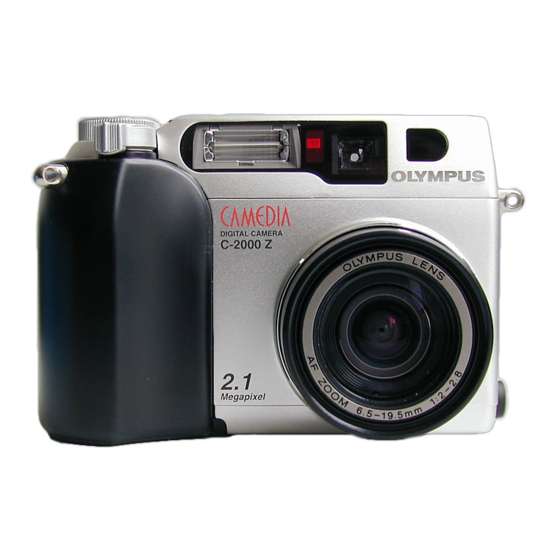
Olympus C-2000 Instructions For Use Manual
Digital stills camera
Hide thumbs
Also See for C-2000:
- Instruction (248 pages) ,
- Troubleshooting (3 pages) ,
- Brochure & specs (2 pages)
Table of Contents
Advertisement
Advertisement
Table of Contents

Subscribe to Our Youtube Channel
Summary of Contents for Olympus C-2000
- Page 1 Digital Stills Camera User Guide...
-
Page 2: Table Of Contents
Contents Basic operation Switch on…………………3 Shooting modes…………..3 Viewfinder………………..4 Zooming…………………..4 Taking the picture…………4 Viewing the picture……….5 Deleting a picture…………6 Advanced operation Exposure compensation………………7 Eposure compensation - examples…8 Aperture priority……………………………8 Depth of field – examples…….…….9 Shutter priority………………………….….10 Shutter speeds – examples…..……..11 Flash options Auto………………………12 Forced…………………….12 Anti Redeye………………12... -
Page 3: Basic Operation
These instructions are for the Olympus C-2000 digital stills camera. Basic Operation Switch on TAKE OFF THE LENS CAP!!!! This must be done before switching on the camera. DAMAGE WILL OCCUR IF THE LENS CAP IS NOT REMOVED WHEN THE CAMERA IS SWITCHED ON. -
Page 4: Viewfinder
Viewfinder You have a choice of viewfinder. You can shoot using the optical viewfinder or the LCD display. Note that using the LCD drastically reduces the battery life. To use the LCD display, first select your shooting mode (P, A or S) then press the LCD on/off switch. The LCD display will now show a Preview;... -
Page 5: Viewing The Picture
After the picture has been taken, it is saved in the camera’s memory. It is also displayed on the LCD for a few seconds as a confidence check. The memory can hold about 15 shots, dependent on picture content. The LCD on top of the camera displays the number of frames remaining. -
Page 6: Deleting A Picture
5. If you wish to delete any shots, just display on LCD in viewing mode then press the LCD on button. 6. You will then be asked for confirmation; if you are sure then press OK. 7. To turn off the LCD screen you must come out of viewing mode and back to a shooting mode (P, A or S). -
Page 7: Advanced Operation
Advanced Operation There are several options available to you to become more creative in your picture taking. These options include exposure override, aperture control, shutter control, focus and flash. Exposure Compensation This would be used when you know that the meter on the camera could be fooled. -
Page 8: Eposure Compensation - Examples
Here are some examples of exposure compensation: Aperture Priority (A) This is another shooting mode which gives you more creative control. You would use this to throw a background out of focus whilst keeping the subject sharp (small aperture number). Alternatively you can have the foreground and the background in focus (large aperture number). -
Page 9: Depth Of Field - Examples
If there is not enough light to take a picture at your selected setting, the camera will warn you by flashing the settings in red when you half press the shutters. You must select either another mode or aperture setting. Remember: Small “F”... -
Page 10: Shutter Priority
Shutter Priority This is the third shooting mode. It gives you another creative tool as it allows you to vary the time the shutter is open. This has the effect of freezing motion at high shutter speeds and blurring motion at low shutter speeds. -
Page 11: Shutter Speeds - Examples
Here are some examples of different shutter speeds. Slow Shutter speed Fast shutter speed... -
Page 12: Flash Options
Flash Options The camera has a built in flash which is controlled by the camera itself. The flash has several modes, but the amount and the duration of the flash are automatic. The modes available are Auto, Forced (fill in), Anti Red Eye and off. The different flash modes are available in each of the shooting modes (P, A and S). -
Page 13: Off
Flash Off This mode would be used where a flash would be intrusive or dangerous, such as sporting events. To change flash mode: 1. Turn on LCD in any shooting mode ( P, A or S). 2. Press “Menu” , you should now see the menu displayed. -
Page 14: Fill In Flash - Examples
Forced flash (fill in) Anti Redeye Flash off 6. Once the you are happy, you press “Menu” again to lose the menu. You can then switch off the LCD. You will also get a confirmation symbol on the top control panel. No flash Forced flash No flash... -
Page 15: Focus
Focus This camera has an automatic focus system. It will focus on whatever is in the crosshairs on the viewfinder. This means that if the subject is not in the centre of the screen, it will not be in focus. To combat this you must first frame up the shot so that the subject is in the crosshairs. -
Page 16: Macro Mode
Macro Mode This mode allows you to shoot an object very close up. You would use this to shoot a flower head for example. To use the macro mode, the subject needs to be between 20cm and 80cm from the lens. Note that at this close range, what you see through the viewfinder is not quite what you get recorded. -
Page 17: Miscellaneous
Miscellaneous If this symbol starts to flash, then the batteries need changing. Please take note of the orientation of the batteries (there is a schematic diagram under the camera). The camera will go into standby mode if not operated for more than 3 minutes. After 4 hours the camera will switch off.





Need help?
Do you have a question about the C-2000 and is the answer not in the manual?
Questions and answers